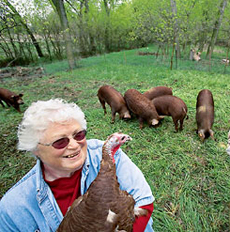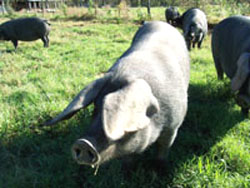

Standard American Bronze turkeys were standard for more than a century, but now are reduced to just 950 breeder birds. In the rear, Red Wattle pigs were thought to be extinct until a wild herd surfaced in Texas. Thanks to dedicated family farmers and enthusiastic chefs and gourmets, these breeds are coming back from the brink of extinction. Photo by Joel Sartore, courtesy of Time magazine.
November 2005
|
 |
Heritage Meats
The Resurrection of America’s Endangered Breeds
Only fifty years ago, when a chef called for the finest meats to prepare meals for discriminating gourmets, he could count on his purveyors to bring him Standard American Bronze and Bourbon Red turkeys...Red Wattle and Tamworth pigs...Katahdin and Tunis lamb. These breeds of fowl, pig, lamb and beef with distinctive, succulent meat were common on family farms.
But as with the rest of our agricultural heritage, the post-World War II industrial boom turned family farm business into big AgriBusiness. The same thing we’ve seen happen to our fruits has happened to our meats.
Fine flocks and herds died out. What few animals remained did so on family farms, for the family’s own consumption. These numbers from the American Livestock Breeds Conservancy tell the sorry tale:
- Fifteen different breeds of pigs were raised for market in the 1930s. Today, six of them are extinct. Three varieties of pig (Hampshire, Yorkshire and Duroc) account for 75% of U.S. production, limiting the flavor portfolio.
- In the 1920s, more than 60 breeds of chickens were raised in America. Today one hybrid, the Cornish Rock cross, is the one breed found in most supermarkets.
- A single breed turkey has been bred for the American table: the Broad Breasted White. It is a commercially-engineered bird with such a huge breast and short legs that it is unable to mate naturally.
Yes, AgriBusiness is Big Business, and its goal is to maximize margins in a competitive market. Large corporations have bought up the family farms, and they develop products that can be mass-marketed: the duck or turkey with the larger breast is what the majority of Americans prefer over the smaller-breasted but tastier bird.
Unfortunately, catering to the mass market has two consequences:
- Narrowing the genetics to emphasize some traits means losing others. As we’ve seen with our fruit supply, it caters to the lowest common denominator of palatability: in order to achieve a beautiful red apple or tomato with long shelf life that’s durable in transit, the flavor is sacrificed.
- Second, to achieve the desired result, traits are bred out that can protect against extinction, like resistance to disease and drought, intelligence, easy birthing and longevity. And, as in the case of reducing the choice of almost 300 million people to three hog breeds, one chicken breed, and one turkey breed, we have what ecologists call monocultures—vast numbers of a single variety of breed.
Alarmed at the trend, the U.S. Department of Agriculture is creating a national gene bank in Fort Collins, Colorado, for endangered livestock.
Gourmets To The Rescue
What could be another sorry tale of extinction is turning out to have a happy ending. The increasingly sophisticated American palate has engendered consumer awareness and demand for the best ingredients. A fresh generation of chefs, always on the prowl for new flavors and textures, has sought out foods at farmers markets and found the products of the few farmers who had heirloom stock. The chefs brought the cherished meats to their customers,who responded with great enthusiasm. This new demand has given the farmers the capital with which to raise more animals—some have seen their incomes double over the past few years. And slowly, some heirloom breeds are returning.
According to the American Livestock Breeds Conservancy: |
 |
| Thanks to a good amount of intra muscular fat, the Large Black hog is extremely moist, juicy and flavorful. It has a strong texture in the mouth yet is soft and delicate to chew it. The Black produces smallish shoulders—hence not selected by Big Agriculture—but tasty lean hams. There are fewer than 200 registrations of Large Blacks in the United States. Hams are available through Heritage Foods USA. |
- In 1997, from eight traditional varieties, only 1,335 breeding turkeys were found nationwide, including just six of the splendidly black-and-white-feathered Narragansetts. Today the total has grown to 5,363, including 686 Narragansetts.
- Highland cattle and Shetland sheep are also re-generating.
- For the first time in 50 years, rare Barred Plymouth Rock chickens from farms in Michigan and Kansas are on the market (Heritage Foods USA).
In addition to being a taste-good product, heritage meat is a feel-good product. Most livestock are organically fed and humanely raised in free-range conditions. Hogs root around in the woods, turkeys pull worms from the ground with their natural, un-clipped beaks.
And how good does it taste? In addition to a succulence and texture not found in commercially-produced varieties, free-range meat is more marbled meat, high in omega-3 essential fatty acids. If you haven’t yet sampled the pleasures, ask your favorite restaurateur when you might expect some on the menu; or buy some yourself.
You can do an online search for any of the animals mentioned in this article to find individual farmers; or go to Heritage Foods USA, a commercial enterprise which grew out of the Slow Food movement, and represents producers of, among others:
- Barred Rock and Dark Cornish chicken
- Katahdin, Tunis, and Romney lamb
- Berkshire, Duroc, Tamworth, Gloucestershire, Large Black, and Red Wattle pigs
- Heritage turkeys
Lifestyle Direct, Inc. All rights reserved. Images are the copyright of their respective owners.

|